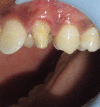Biologic Foundation Restoration: A Natural Post And Core For Management
- PMID: 26199529
- PMCID: PMC4501993
- DOI: 10.1007/s13191-013-0332-0
Biologic Foundation Restoration: A Natural Post And Core For Management
Abstract
Complicated crown fractures are a common outcome of dental trauma. Various treatment options are available for consideration. The preferred choice of treatment though, is determined by multiple factors associated with the nature of trauma itself. This case report highlights the management of a cervical crown fracture by modifying the clinical technique of an existing concept of the "Biologic Post and Core" and integrating it with current advances in adhesive technology, with an intention for preservation and reinforcement of residual tooth structure. The clinical success observed during subsequent patient recall has given reason for optimism in considering the employed method as a possible alternative to address this area of prosthetic concern.
Keywords: Biologic foundation restoration; Coronal fracture; Natural tooth post and core.
Figures






Similar articles
-
Multidisciplinary approach of complicated crown fractures of both superior central incisors: a case report.Dent Traumatol. 2008 Aug;24(4):482-6. doi: 10.1111/j.1600-9657.2008.00572.x. Dent Traumatol. 2008. PMID: 18721354
-
Multidisciplinary approach to the management of complicated crown-root fracture: a case report.J Int Oral Health. 2015 Apr;7(4):88-91. J Int Oral Health. 2015. PMID: 25954080 Free PMC article.
-
Clinical management of a complicated crown-root fracture: a case report.Braz Dent J. 2011;22(3):258-62. doi: 10.1590/s0103-64402011000300014. Braz Dent J. 2011. PMID: 21915526
-
Factors affecting the fracture resistance of post-core reconstructed teeth: a review.Int J Prosthodont. 2001 Jul-Aug;14(4):355-63. Int J Prosthodont. 2001. PMID: 11508092 Review.
-
Techniques for immediate core buildup of endodontically treated teeth.Quintessence Int. 2003 Apr;34(4):258-68. Quintessence Int. 2003. PMID: 12731611 Review.
References
-
- Chosak A, Eidelman E. Rehabilitation of a fractured incisor using patient’s natural crown: a case report. J Dent Child. 1964;31:19–21.
-
- Santos J, Bianchi J. Restoration of severely damaged teeth with resin bonding systems. Quintessence Int. 1991;22:611–615. - PubMed
Publication types
LinkOut - more resources
Full Text Sources
Other Literature Sources
